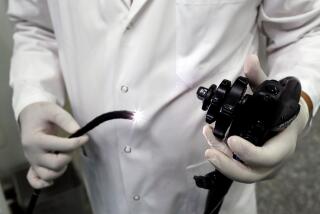Virtual colonoscopy called flawed
Although virtual colonoscopy is being increasingly promoted as a high-tech, less painful way to detect colorectal cancer, real-world experience is demonstrating it can be unreliable.
A comparison study of patients with at least one lesion measuring 10 millimeters or more found that virtual colonoscopy detected the lesions -- tissue abnormalities such as small tumors or polyps that can develop into cancers -- 55% of the time. When a standard colonoscopy was used, the test found all the lesions. For patients with at least one 6-millimeter or larger lesion, virtual testing detected 39% of the lesions, contrasted with 99% for standard colonoscopy.
The results were reported in the current issue of the Journal of the American Medical Assn. by researchers at the Medical University of South Carolina in Charleston. They reviewed screenings of 615 patients older than 50 at nine medical centers. The patients were first screened with a virtual colonoscopy, then later the same day by standard colonoscopy. The radiologists doing the tests were required to have done at least 10 virtual procedures -- a relatively small number -- and doctors at only one of the nine centers had substantial experience with the technique, the authors noted.
Patients should realize that both standard and virtual procedures require bowel-cleansing preparations, which many people find unpleasant. But the virtual procedure does not require that patients be sedated, so they can return to work or other activities immediately. With the virtual procedure, the doctor doesn’t need to snake a slim, lighted tube through the colon, as with a standard colonoscopy. But the virtual exam still requires that a tube be inserted into the rectum to inflate the colon with air. Any polyps found can only be removed through the invasive procedure.
Many of the patients who receive virtual colonoscopies are referring themselves for the tests. The virtual exams are not covered by most health insurance plans, except where standard colonoscopies have failed or patients couldn’t tolerate them. At $500 to $2,000 per exam, the virtual colonoscopy represents a source of revenue for doctors and clinics, some of whom directly market the tests to patients and advertise discounted fees.
With more doctor training and additional refinements, virtual colonoscopy has significant potential, doctors say. Last December, Dr. Perry J. Pickhardt of the University of Wisconsin reported in the New England Journal of Medicine that virtual colonoscopy using software that first assembled each of the sliced views into a continuous three-dimensional image of the colon, followed by two-dimensional images to confirm suspected abnormalities, picked up 98.3% of polyps larger than 10 millimeters. In the JAMA study, however, doctors relied primarily on two-dimensional images.
Dr. Ira Smalberg, a Los Angeles radiologist, interprets two to three virtual colonoscopies weekly for Heart Check Los Angeles, which charges $950 for the same high-tech virtual colonoscopy that Pickhardt used. He criticized the JAMA study for using radiologists with insufficient virtual colonoscopy experience. “Nobody should be interpreting a virtual colonoscopy study after only 10 cases. The study just highlights the need for well-trained, dedicated radiologists.”






